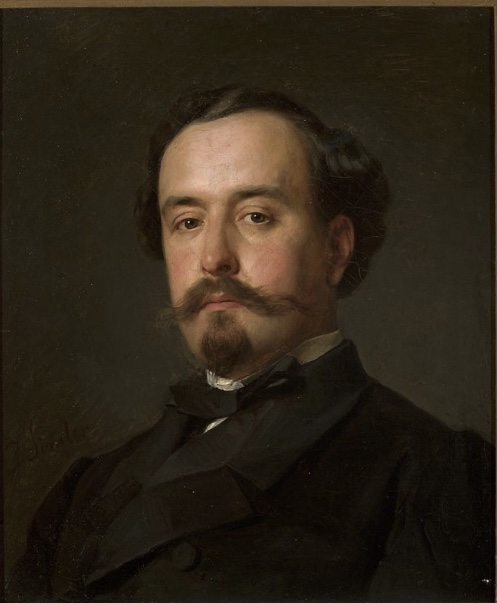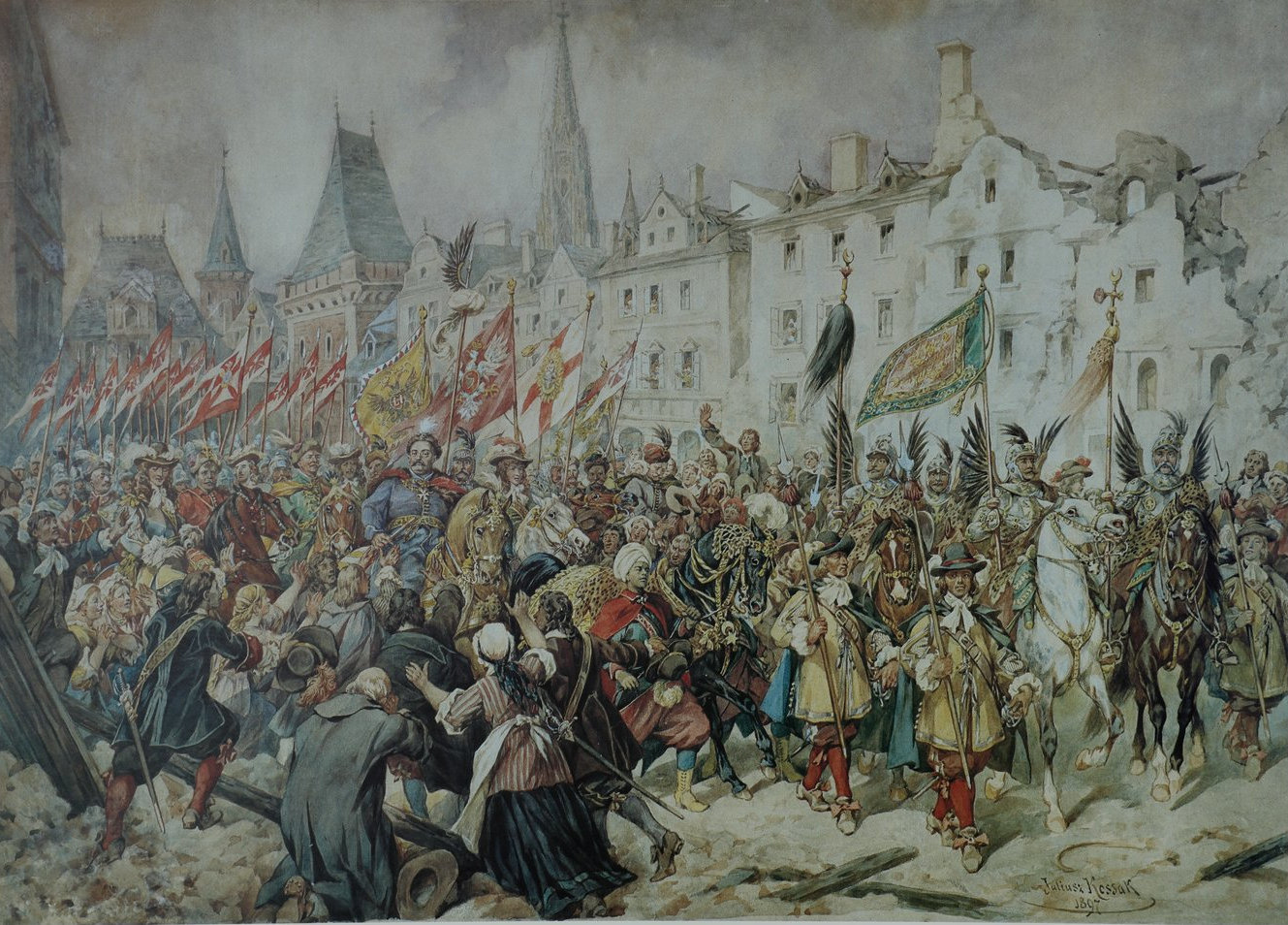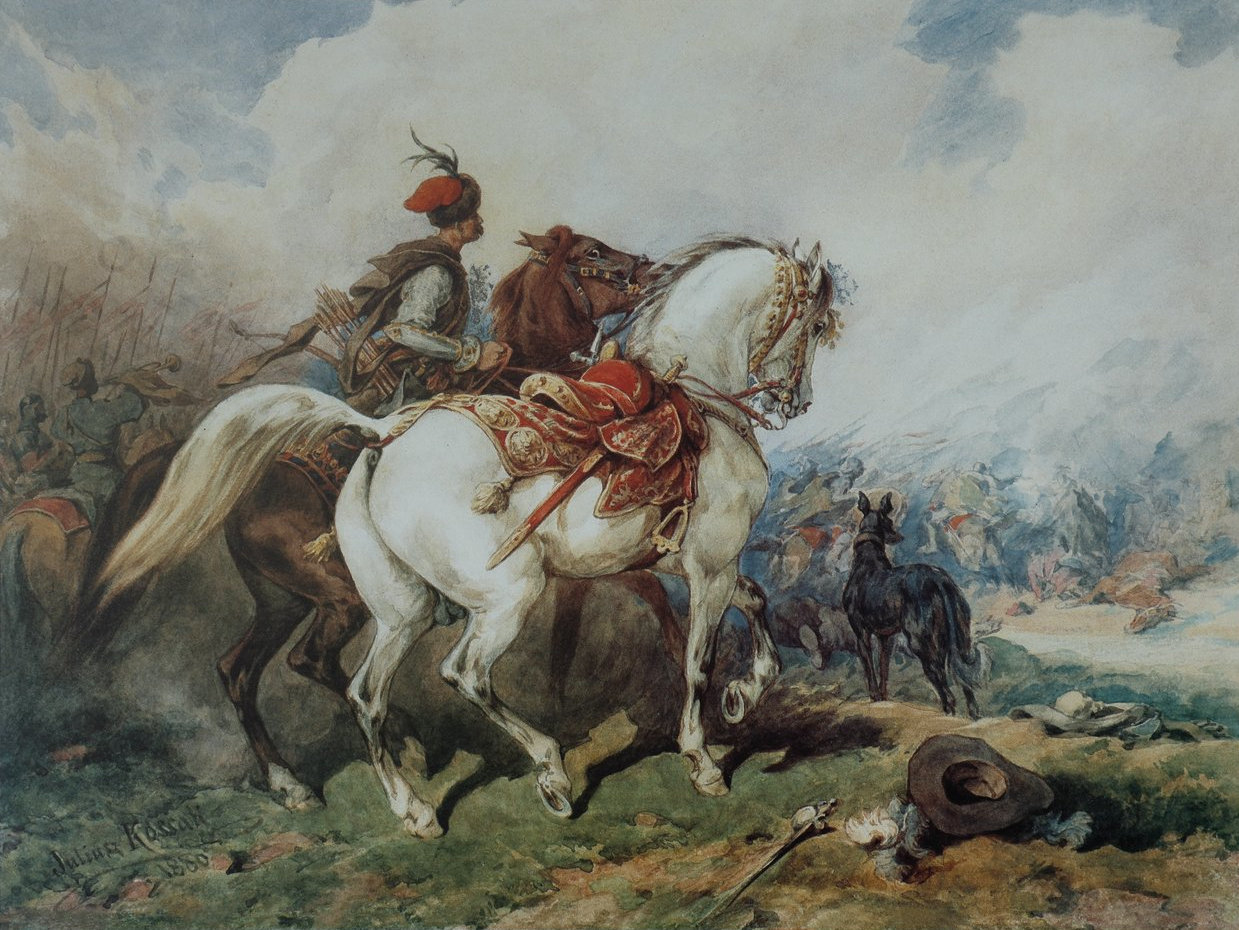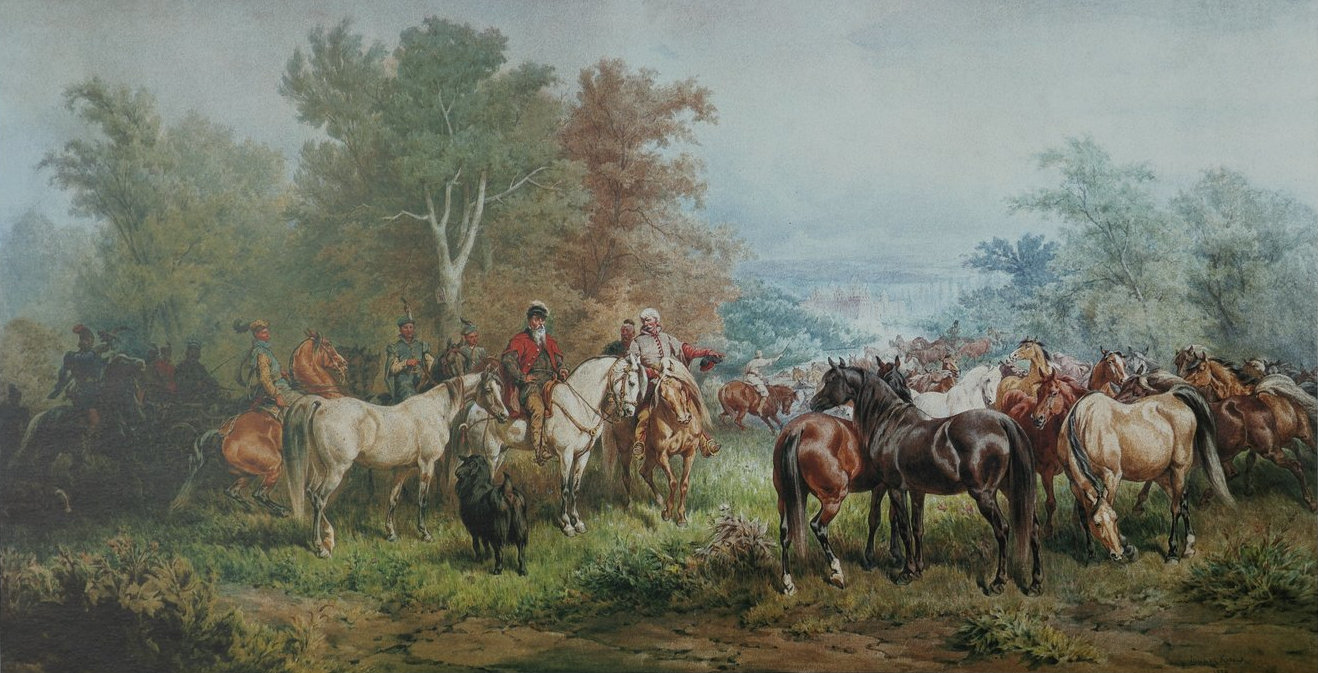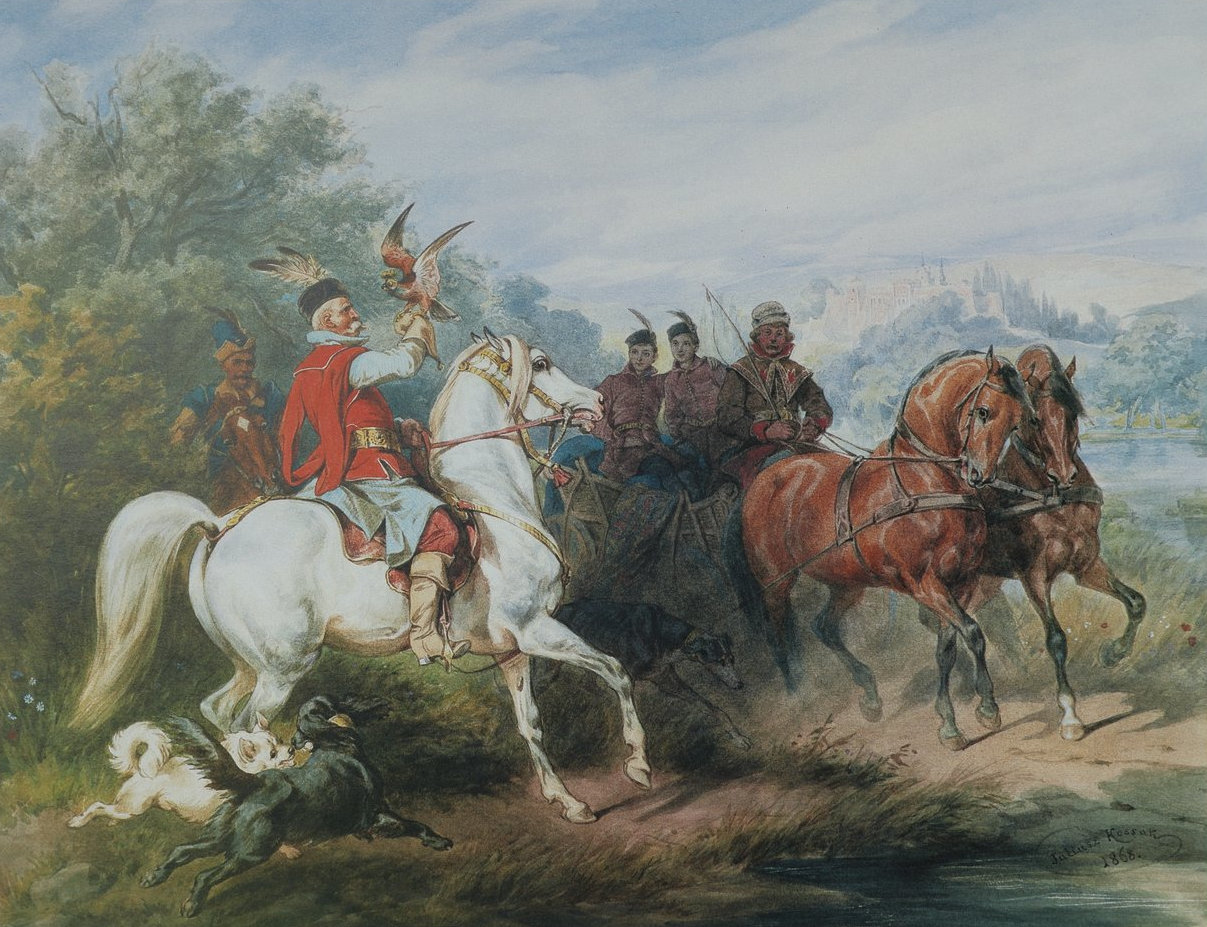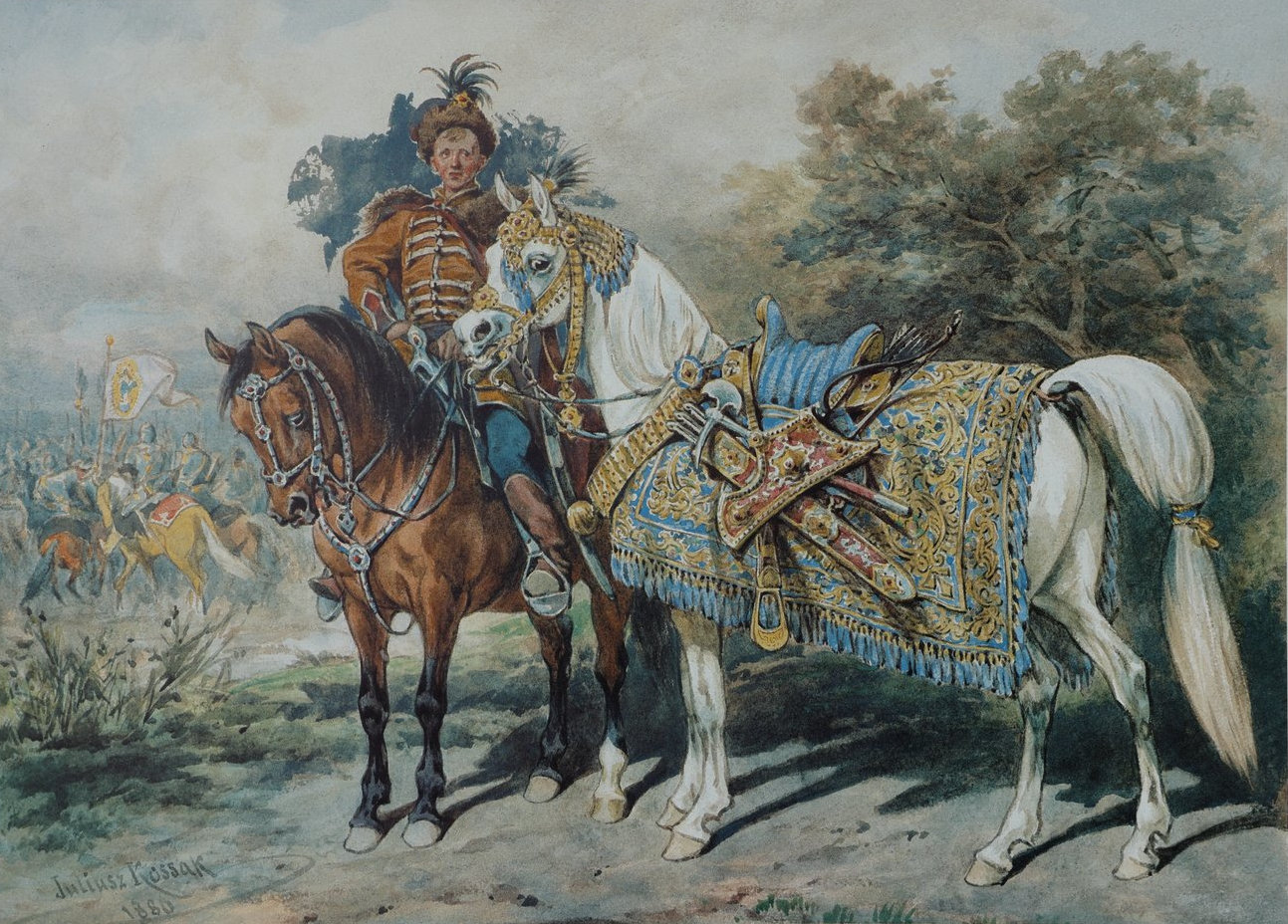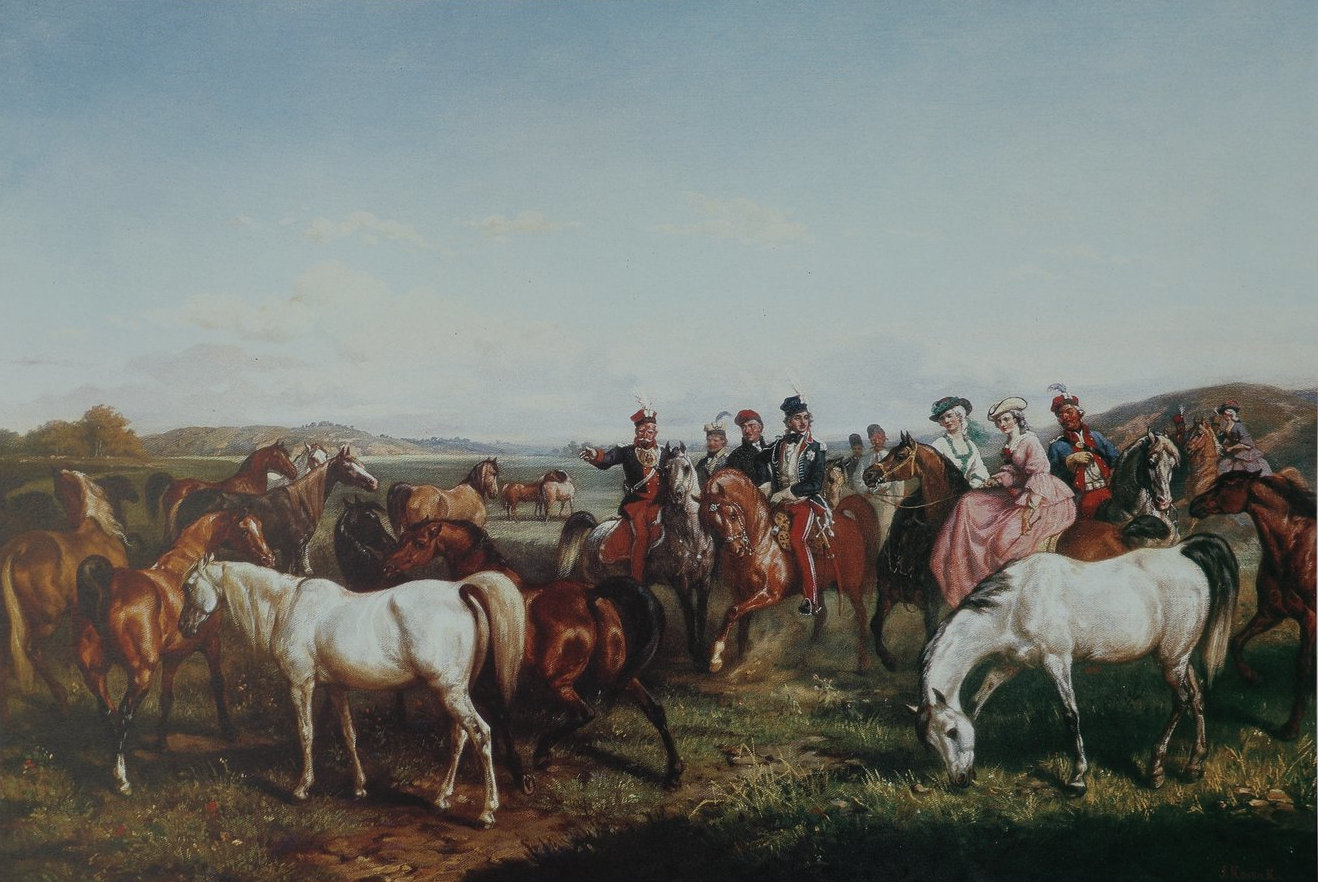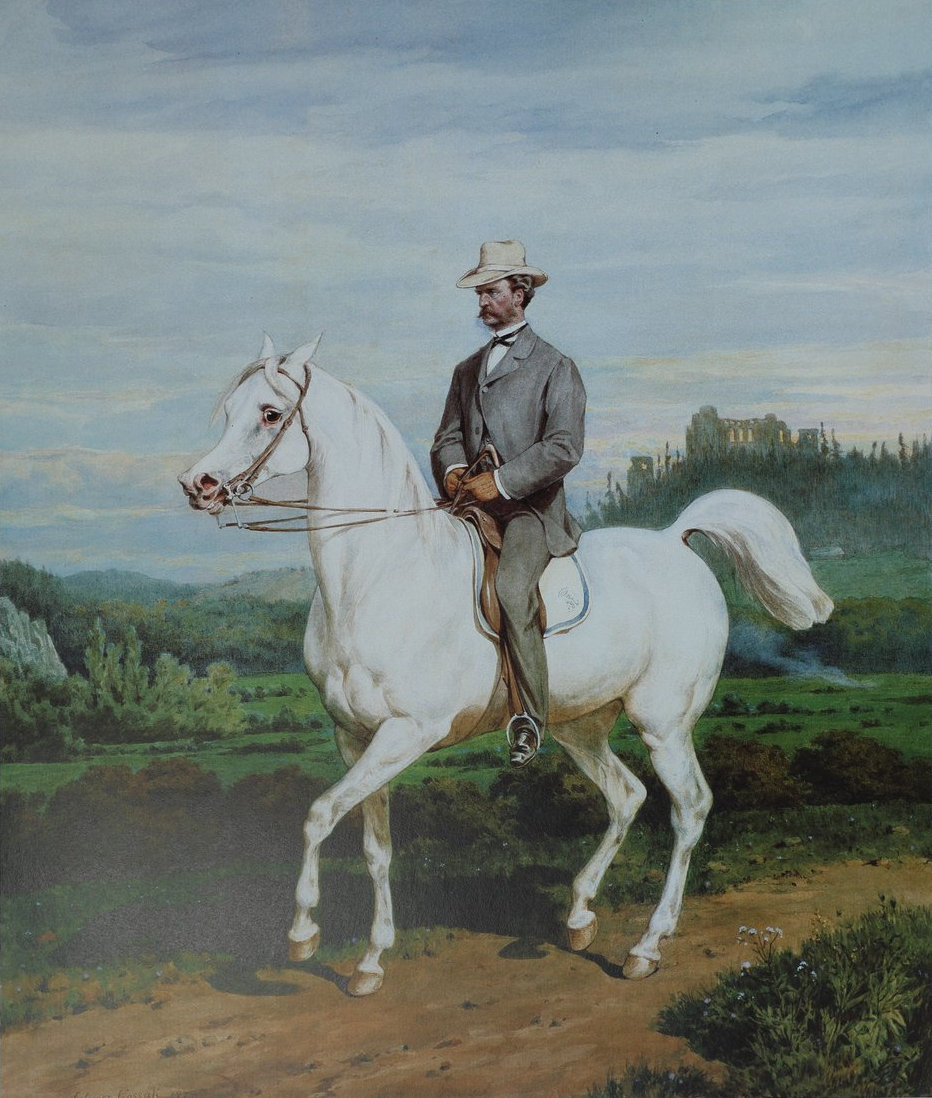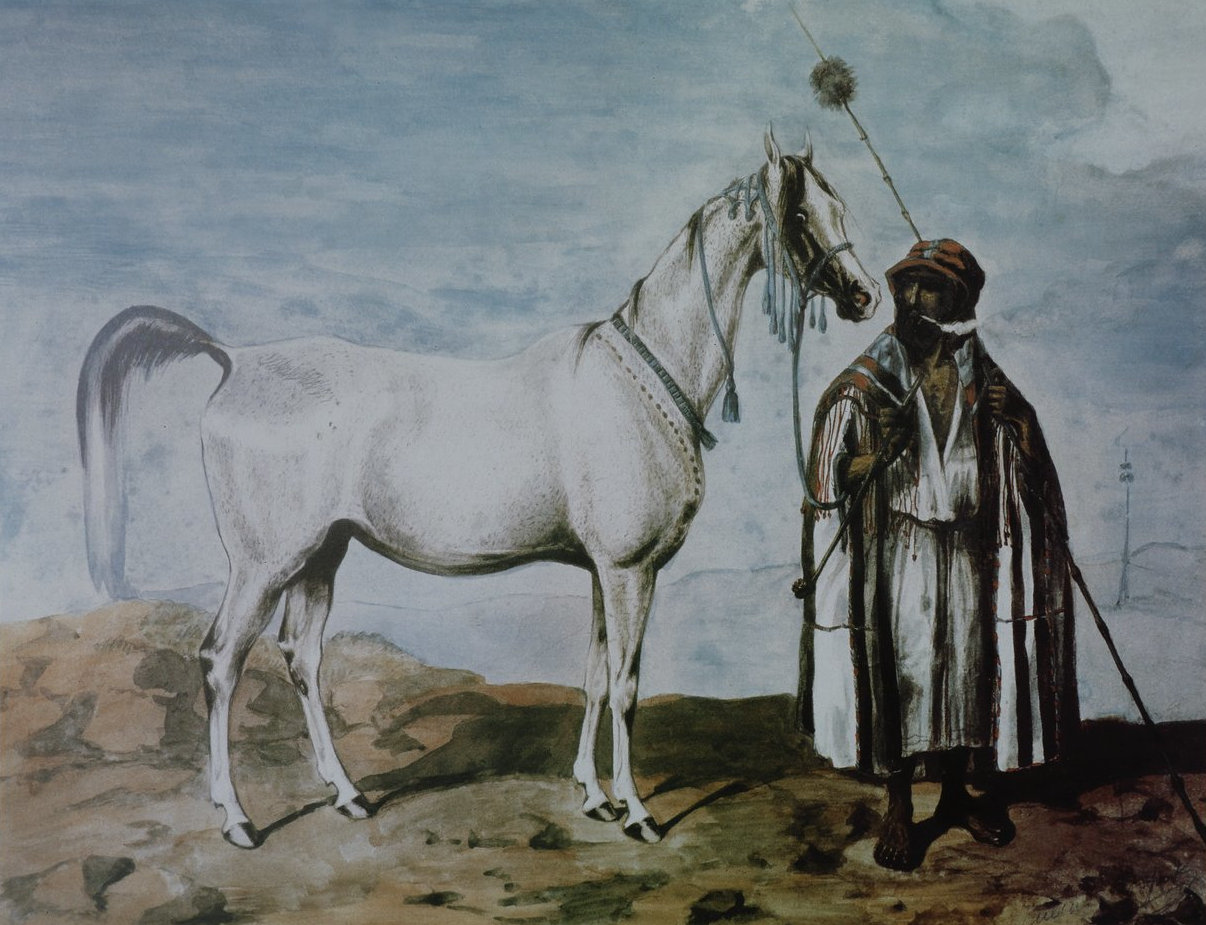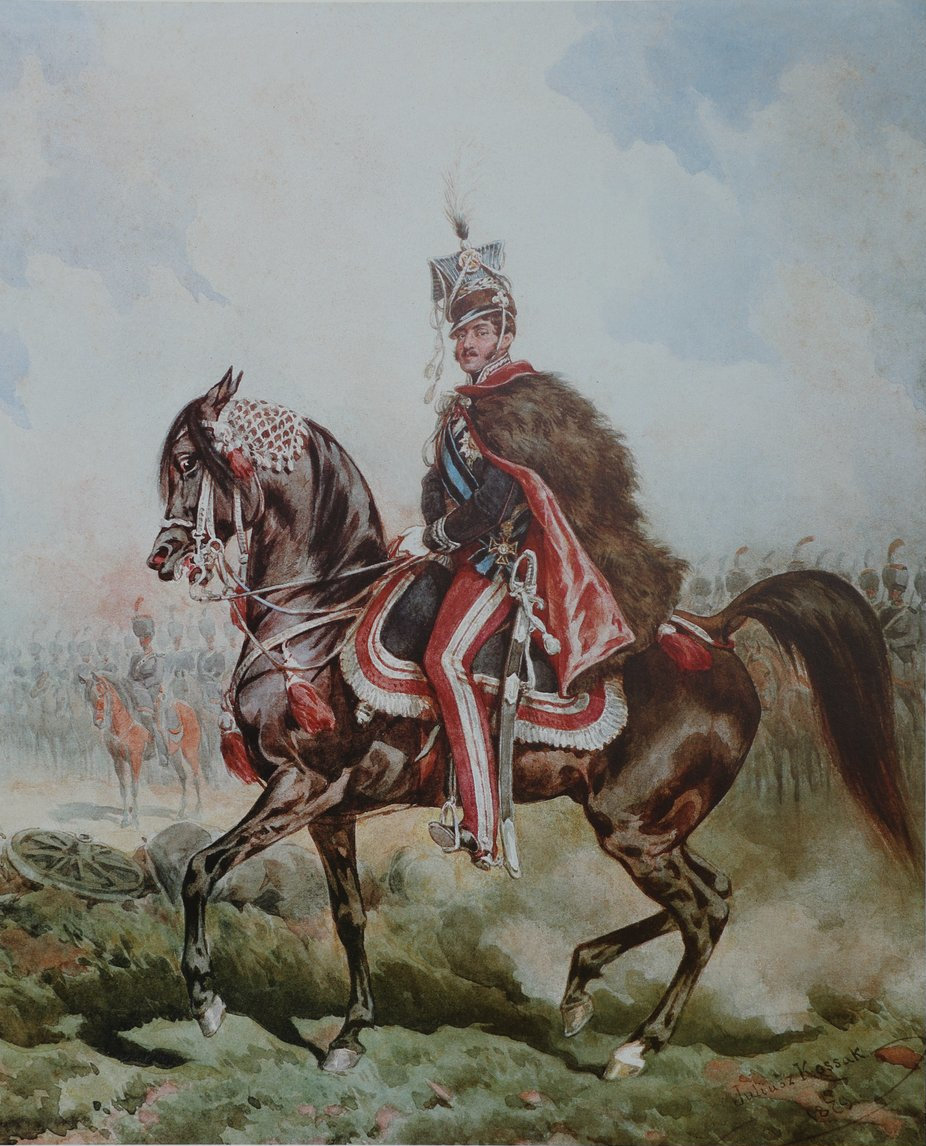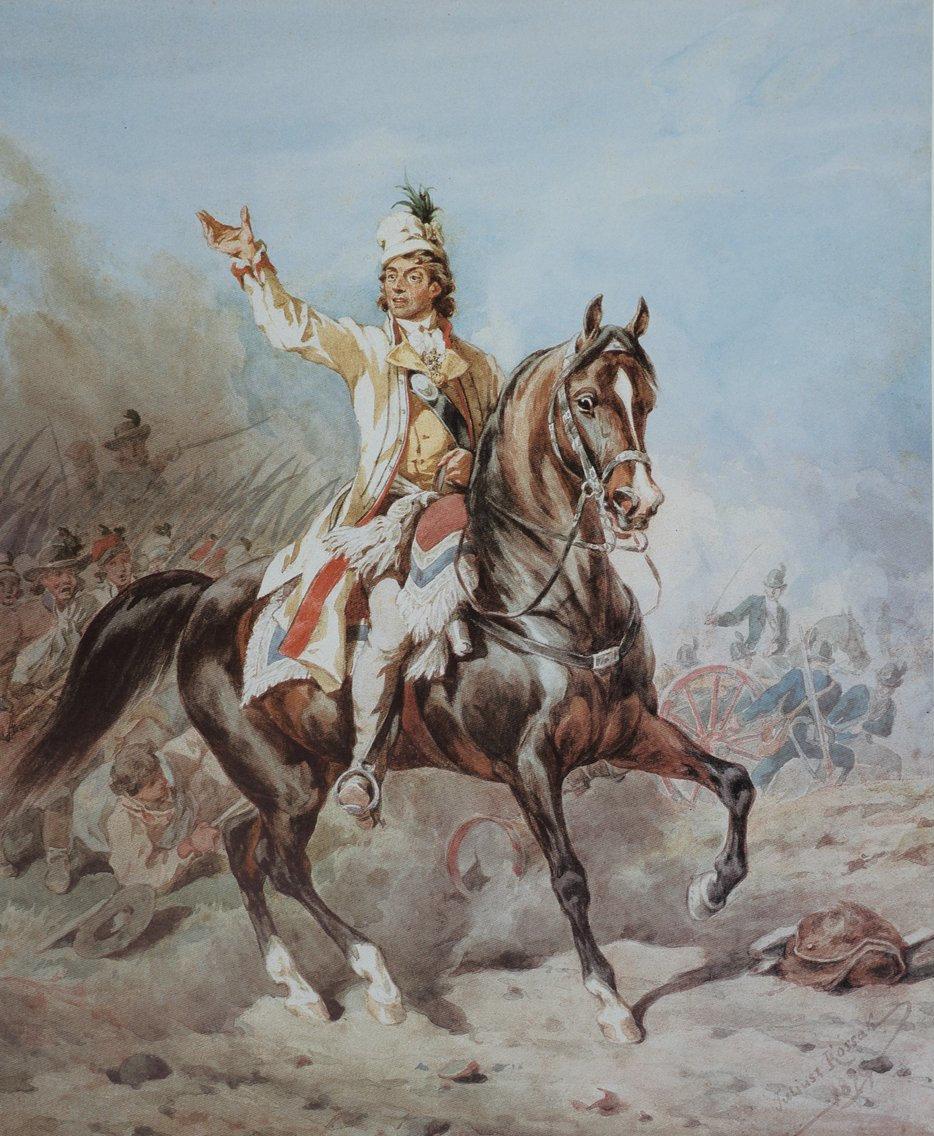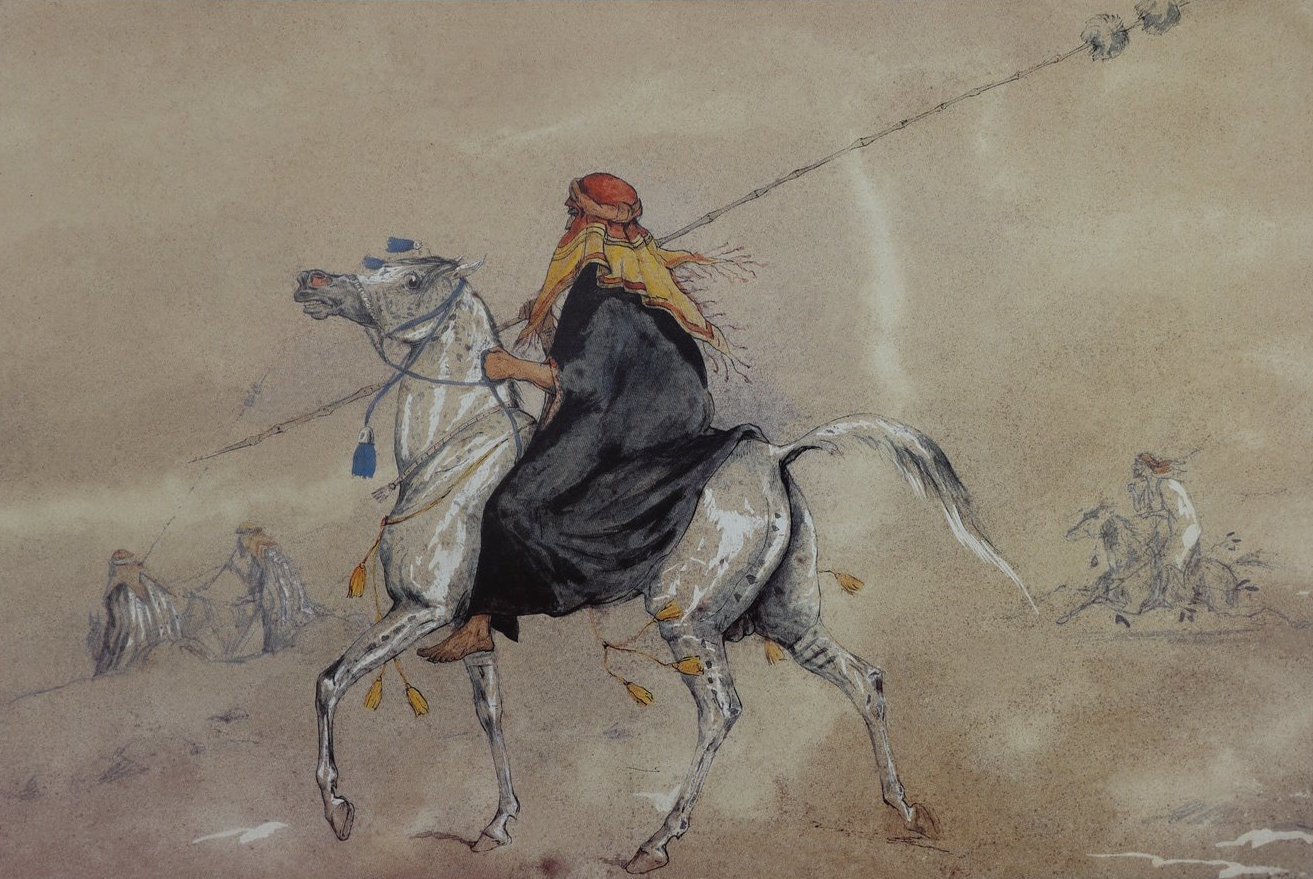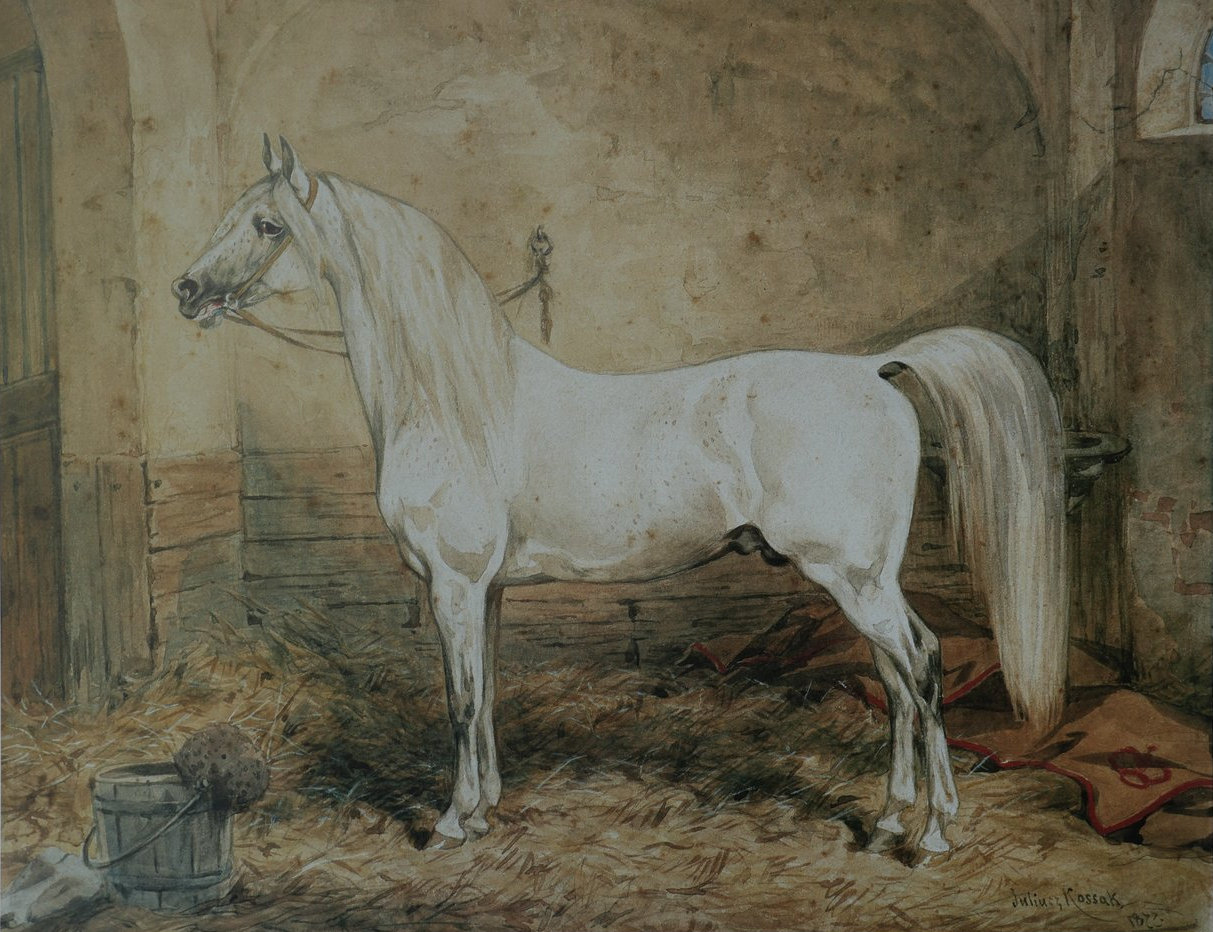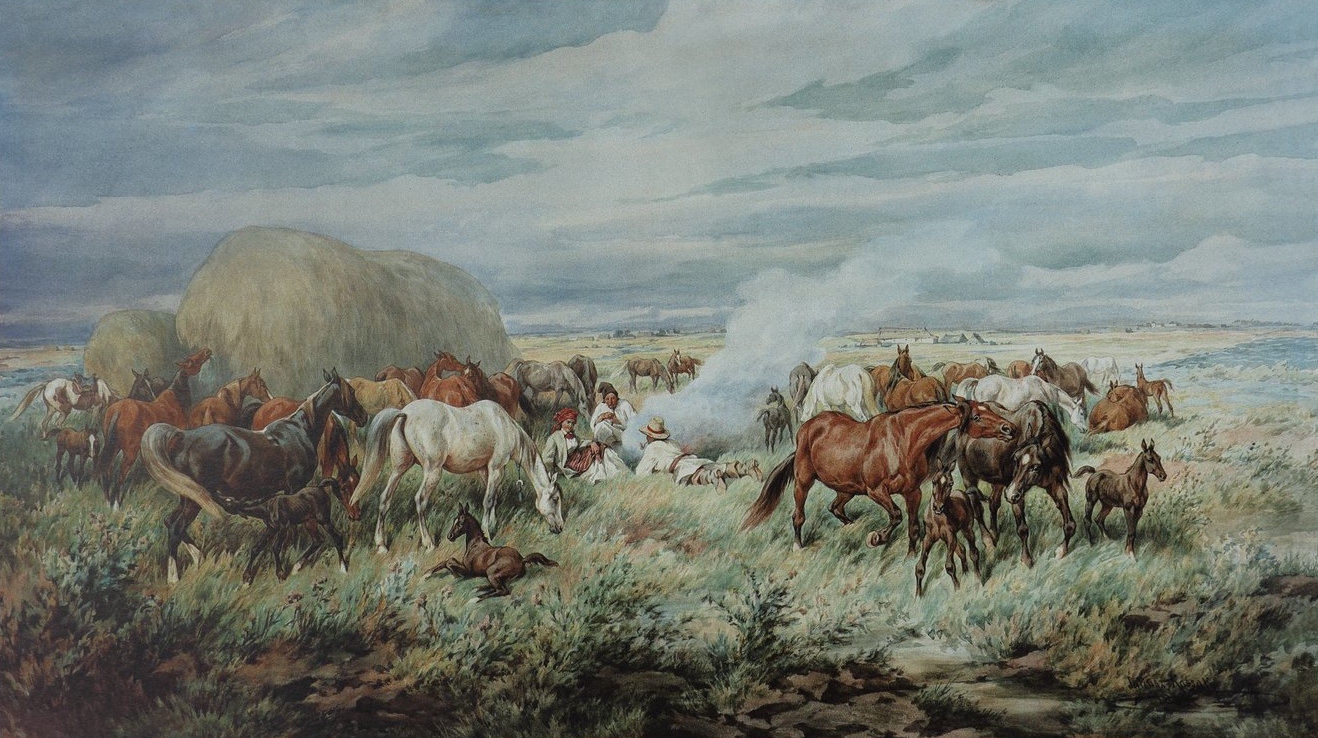NEWS
2024-12-15
JULIUSZ KOSSAK (1824-1899) (on the 200th anniversary of his birth)
Józef Simmler, Portrait of Juliusz Kossak,
source Wikimedia
Author: Hanna Sztuka
“It
is common knowledge that no one before or after Juliusz Kossak made the Polish horse and its
breeding as famous as he did. Therefore, this painter particularly deserves to be remembered among
Polish horse lovers.”*
For breeders
of Arabian horses, Juliusz Kossak is an icon and a constant source of inspiration. Therefore, it
seems strange that his character has been somewhat forgotten, although we still enjoy his works.
This year we celebrate the 200th anniversary of Juliusz Kossak's birth. The artist was born on
Oktober 29h, 1824.
Wawrzyniec Fredro in the
mission to Istanbul
Some Polish artists, each in their own way, are
highly mythologized figures. Juliusz Kossak was and is one of them, coming to the forefront of this
group. He was among the avant-garde icons of 19th-century Polish painting, alongside Matejko,
Grottger and Brandt. Kossak's painting myth is encapsulated in several symbols: a horse, a knight's
saber, Sarmatian history. “An old-fashioned fairy tale told
by the fireplace by old ladies and eternal bachelors. To whom is it told? “It is astonishing that
they are invariably young and the youngest of contemporary collectors.” ** Wincenty Łoś
in "Tygodnik Ilustrowany" [“Illustrared Weekly”] from 1895 characterized the work of Juliusz Kossak
as follows: "Kossak's individualism meant that he achieved
one of the most difficult art of painting, that he spoke to wide circles, moved them for a very long
time and with the help of not enormous dimensions and happy with the content of pictures, only with
watercolors.” Juliusz Kossak is a painter strongly associated with Polish literature,
but he did not inspire writers like Matejko, but he followed Polish poetry, the literary vision of
the novel, translating the language of words into shape and color. The man who had a huge influence
on his way of perceiving the horse was undoubtedly Juliusz Dzieduszycki, a breeder and aristocrat
who cherished the romantic legend of Wacław Rzewuski, the Polish Emir.
Hunting trip in
Krzeszowice
Many legends arose around Rzewuski. The descendant of
hetmans did not become a great man, he wasted his life pursuing romantic dreams. He didn't get into
history, but he got into the history of literature and through it into painting. And so the
incomparable Farys had numerous successors in Polish Ukraine and Podolia. One of them was Juliusz
Dzieduszycki.
Entry of Jan III Sobieski into
Vienna
Juliusz Kossak had in Count Dzieduszycki was not only a
friend and patron, but also a master who taught him how to look at the Arabian horse, so close to
the heart of the famous breeder. It was with Juliusz Dzieduszycki that Kossak became acquainted with
Podolia, its colors and excellent horses. As Stanisław Tomczykiewicz wrote in 1899, "It's no wonder that watching with Count Juliusz Dzieduszycki the
descendants of the famous mare of Muhammad, Kossak forever remembered the type of a small bachmat,
with a lively eye, open nostrils, a lush mane, and a long, set-off tail. This concept of a horse
will never leave him [...] His ideal will forever remain Emir Rzewuski's steed, about which Słowacki
says: "His Arabian horse was white without blemish."
Servant with a
horse
Juliusz Kossak - life and work
In the
"Herbarz Polski" [“Polish Peerage”] we find the following entry: "Kossak Michał, born in 1798, criminal counselor in Wiśnicz, married Antonina Sobolewska,
co-heiress of Knihinin." Juliusz Kossak was born in Wiśnicz on December 15th, 1824 and
was the oldest of five children in the Kossak family. Kossak was ten years old when his father died.
The family had been residing in Lviv for several years at that time. In accordance with his father's
will, Juliusz graduated in law from the University of Lviv. However, already at the Basilian school,
Juliusz showed great talent for drawing, gaining recognition among his classmates and
professors.
Jan Tarnowski's Hetman's
Stud
After graduation, taking advantage of the first opportunity,
the young law student set out on his first artistic journey (1844). He decided to become a painter.
Today it is difficult to recreate all the stages of this youthful journey. Kossak was certainly
among the Dzieduszycki family: Kazimierz in Niełościów, Juliusz in Jarczowce and Władysław in
Jezupol. He was a guest in Antoniny of the Potocki family, Sławuta of the Sanguszko, Sawrań of the
Rzewuski, Łańcut of the Potocki, Rajtarowice of Władysław Rozwadowski and also in Biała Cerkiew of
Władysław Branicki, who was his next patron and friend. Therefore, he got to know the famous
and distinguished stud farms from which modern Polish Arabians are bred, and he portrayed
particularly outstanding horses at the request of their owners. In Łańcut, Kossak met Piotr
Michałowski, already a renowned painter, who advised his young friend: "Young man, if you want to paint horses, for which I see a natural talent in you, learn
first of all the anatomy of a horse - without it, the future of your talent will be
ruined." The future proved that young Kossak listened to this valuable
advice.
Falcon hunting
trip
The first drawings of horses, still a bit shy, clumsy and a bit
stiff, already reveal the scale of his talent and - most importantly - his instinctive understanding
of the horse. Portraits of pure-bred Arabian horses from Juliusz Dzieduszycki's herd, imported from
the desert, have survived: the stallion Koheylan and the mares Gazella, Mlecha and Sahara - all
painted in 1845 in Jarczowce. In his watercolors, Juliusz Kossak brilliantly reproduced the
characteristic features of the horses' structure: the shape of the head, the position of the neck,
the shape of the croup and the shades of coat. These portraits are a valuable source of study for
modern breeders. The English-style engravings of the horses, however, reflected the Polish reality
with Kossak's charm. Juliusz Kossak was able to convey, like no one else, the features
characteristic of the breed, type and individuality of the horse. Paintings with scenes of hunting,
horses and dogs were an indispensable decoration of offices, hunting rooms and halls of 19th-century
Polish houses.
In the background of the
battle
Already in this first period, the basic sources of Juliusz
Kossak's art can be seen, determining the character of his style. These will include stud farms,
Polish and Oriental horses, and battle scenes in the style of Horace Vernet. Already in his youth,
Kossak found his own style of painting horses. Wincenty Morawski, who sympathetically observed the
artistic development of young Kossak, wrote about him in 1849: “His drawings are naturally as faithful as a daguerreotype. Lush and beautifully grouped
compositions, all the more beautiful because, being a student of nature and his own abilities, he
does not know academic rules and freely lets his imagination run wild. His "force" are sketches in
pencil, pen and watercolor, in which horses play an extraordinary role.”
Mohort presenting the stud
farm
Juliusz Kossak was able to skillfully associate European
traditions of genre painting with native themes that have no analogy in the art of other countries.
The specificity of Polish life in the borderlands was so exotic that even the most critical
newcomers could not resist its charm. Numerous accounts of foreign travelers around Poland are
eloquent proof of this. Juliusz Kossak also noticed all this, recording in a huge number of
drawings, watercolors and oil paintings.
Equestrian portrait of Count
Adam Potocki
The main character of these works was the horse, seen
in all its incarnations of centuries of service for the good of
man.
Remaining in his thoughts among the herds of horses, Juliusz
Kossak left the hospitable Podolia, going to St. Petersburg (1851) together with Władysław Branicki,
the owner of Biała Cerkiew. There he discovered not only numerous works of art, but also gained
recognition among the local artistically trained audience.
In the
stable
After a year-long stay in St. Petersburg, the artist returns
to the country. The road leads through Warsaw. Here, however, Juliusz lacked powerful patrons.
Wanting to save the depleted funds, Kossak takes up a rather lucrative job at that time - photo
retouching. With this pedantic and boring "creativity", the artist does not forget about his
vocation. The fate changes in 1854 when the Potocki family asks the artist to commemorate the
soldier's death of Stefan Potocki at Żółte Wody. This will be the young painter's first test of
strength in the field of battle and historical painting, which was particularly valued at that time.
Undoubtedly, "The Battle of Yellow Waters" is one of the most important paintings in Juliusz
Kossak's work. Stanisław Witkiewicz expressed an interesting opinion about this work: "Kossak, very early on, at the very beginning of his work, gave horses
movements that were completely real, or very close to the truth. In the painting depicting the
Battle of Yellow Waters, the white horse rearing under Stefan Potocki is identical in movement to
the horses recreated using snapshot photography, and this painting was painted in
1854.” (the snapshot photo dates back to 1888)
Mlecha
In 1854, Juliusz Kossak met the woman of his life in
Warsaw, and in the same year Zofia Gałczyńska, the daughter of an officer of the Kingdom of Poland,
became his wife. The young couple went on their honeymoon to Paris, where the artist spent four
years studying painting. There, on New Year's Eve 1856, a pair of twins were born: Tadeusz and
Wojciech. The Kossak painting dynasty had an heir to the throne. Juliusz takes his first steps in
the capital of France to the studio of Horace Vernet. But the master, absorbed in orders, does not
bother to take care of the young Pole. Vernet gave an extremely favorable opinion about the Pole's
talent, but that was where his education ended.
Prince Józef Poniatowski on
Szumka
After four successful years in Paris, Kossak returns with his
family to Warsaw (1860). A new chapter in Juliusz's work opens here when he takes over the
management of the graphic department of "Tygodnik Ilustrowany" (1862). The illustrations of poems by
Wincenty Pol, Adam Mickiewicz, and later, the masterpieces of Henryk Sienkiewicz, created at that
time, allow Juliusz Kossak to take an honorable place next to Jan Matejko and Artur
Grottger.
Tadeusz Kościuszko with the
Kosynierzy
With a view to further studies, Juliusz Kossak goes to
Munich (1868), where he stays for less than two years. His stay in Munich did not leave any
significant mark on Juliusz's art. His style was already so established that any external influences
only confirmed the artist in the correctness of the path he had chosen. We will not find anything in
his achievements that could be identified with the name "Munich School", so characteristic of the
work of Józef Brandt, Józef Chełmoński or Alfred Wierusz-Kowalski.
Having
left Munich, which was foreign to him, Kossak returns to Warsaw and, after a short hesitation,
settles permanently in Cracow. Jan Matejko works there and the atmosphere of the old capital creates
a unique microclimate that perfectly suits Juliusz's mentality and preferences. In those years, the
political atmosphere in Galicia was much more friendly for Poles than in the heavily Russified
Kingdom.
Juliusz Dzieduszycki on
Azet
In the quiet studio of a small manor house near Cracow, the
most outstanding works of his talent were created in the 1870s and 1880s. Sketches and studies
accumulated during numerous journeys, as well as collections of works of art, mainly weapons,
fabrics and costumes, constitute an indispensable supplement to the still vivid and undying
imagination.
Although in the initial period of his work Juliusz Kossak was
influenced by English graphics and Horace Vernet, over time he gradually freed himself from this
tutelage to find his own, completely separate face already in the Warsaw-Munich period
(1860-1870).
Kossak's painting is a portrait of smaller and larger Polish
noble families depicted hunting or surrounded by a herd of horses. In this way, Juliusz Kossak
immortalized the history of the nation and its horse heroes, such as Czarniecki, Sobieski and
Poniatowski. Kossak's series of paintings showed the Potocki, Zamoyski, Tyszkiewicz and Morsztyn
families. However, the most wonderful cycle is considered to be the so-called fredrowski
series.
White Arabian stallion in the
stable
Jan Aleksander Fredro, another patron and dear friend of
Juliusz Kossak, a comrade in arms from the 1848 campaign, ordered a series of paintings from him,
including the work "Wawrzyniec Fredro enters Istanbul on a diplomatic mission" (1883). Stanisław
Witkiewicz, who rated this composition very highly, wrote about it: "By painting the entry of the envoy of the Republic of Poland, Kossak wanted to express and
did express the same advantage of the soul over material strength, which he had already shown so
many times amid the clang and roar of battles. Among the crowd of pashas, shining with silk and
gold, with a wealth of furs, weapons, ribbons, and the splendor of horses, among the crowd of
janissaries, Turkish cavalry and the crowd of commoners, without any retinue, without any
decorations that add splendor and dignity, Wawrzyniec rides alone, on a white horse. The horse and
the man seem like a vision from a fairy tale, caused by a magic spell. Beautiful as an enchanted
prince, refined, intelligent, and superior in his expression of refined culture, freedom and sense
of dignity to the entire crowd of the Sultan's slaves, he rides on a horse that has no equal in the
entire crowd. In this painting, Kossak showed how far the expression of thoughts through painting
can reach, without resorting to symbolic signs and artificial suggestions and the viewer's mind. And
yet this image is not only an illustration of a given event, it is a symbol of what sometimes really
happened in history, and what every sublime feeling and passionate soul must have always dreamed
of.”
For today's recipients of Juliusz Kossak's art, and above all,
breeders of noble and Arabian horses, his paintings are a source of observations about the type of
horses of that time. Juliusz Kossak was able to convey, like no one else, the features
characteristic of the breed, type and individuality of the horse. In Kossak's work, if an Arabian
horse - it is a desert one, if on a steppe – then it was ”Polish”, if it was a nobleman on a horse –
then it was Oriental, if a Jew or a peasant, then it was a small, sturdy one. For example, the
painting "The Stud Farm in Podolia" - a herd of horses, most certainly oriental, grazes on the
endless steppe, in the shade of a shed. In the painting we see sequences that we can record in
photography today: mares feeding foals, horses looking at people, one mare chasing away another that
got too close to her foal, and friends scratching each other. Judging by the colors, varieties and
structure, the herd largely comes from strong-marking stallions, so it is even in type. Juliusz
Kossak is characterized by a small number of bay horses. Whether he didn't like them or our
ancestors didn't like them, it's hard to say. But in the old herds, perhaps due to the influence of
gray desert imports, there were not many bay horses. “A
little deeper, without disturbing the animals' freedom, three shepherds are watching over a fire.
This painting is striking in its harmony of horses, people, landscape and weather. The whole thing
can be read as an image of paradise that is far from naive...” *** Juliusz Kossak
retained a special sentiment for noble horses, especially the type of the old Polish horse. This
horse was a particularly attractive subject for many artists. However, none of them gave us a fairly
faithful and objective appearance of this horse, only more or less fanciful and stylized ideas. Only
Juliusz Kossak achieved this. “Juliusz Kossak was able to
masterfully bring out the beauty of the Arabian horse, but also its temperament, look, elegance and
harmony of movements, and one could even say its
soul...“ ****
Stud farm in
Podolia
Juliusz Kossak was the founder of a multi-talented family,
both in terms of painting and literature. The painters are the progenitor Juliusz, his childless
brother - Leon, participant of the uprisings, exiled to Siberia, amateur watercolor painter:
Juliusz's son and continuator - Wojciech, Wojciech's son - Jerzy; finally, Juliusz's second
grandson, son of Stefan, Wojciech's brother - Karol. In the third generation, both of Wojciech's
daughters showed literary talents. We have here the famous poet Maria Pawlikowska-Jasnorzewska and
the writer Magdalena Starzewska-Niewidowska, writing under the pseudonym Magdalena Samozwoniec, and
the daughter of Tadeusz, Wojciech's twin brother, Zofia Kossak-Szczucka-Szatkowska. Recently, the
figure of Juliusz's great-granddaughter, Jerzy's daughter, Wojciech's granddaughter - Simona Kossak,
has also become famous. As a professor of forest sciences, she became one of the first people to
popularize the behavioral ecology of mammals in Poland. In November 2024, the film "Simona Kossak"
showing this extraordinary woman will be released in Polish
cinemas.
Juliusz Kossak died in Cracow on February 3rd,
1899.
Maria Pawlikowska-Jasnorzewska portrayed Juliusz Kossak in the
poem "Grandfather" as follows:
…He
painted with emotion and sunshine
Greys, manes,
hooves dancing and shiny
eyes full of fire
more than those of Spanish women
and the haunches
blown out like soap bubbles,
like groups of
mushrooms, colorful towns and cottages,
and
meadows, heirs with moustaches like
catfish…
Bibliography:
1. Stanisław Ledo’chowski “Juliusz Kossak-piewca urody
konia”: w Koń Polski Rok VII.Nr1(29)1973
2. “Herbarz Polski” t.XI, cz.1
3. Stanisław Witkiewicz “Juliusz Kossak”: Lwów 1906
4. Maciej Masłowski “Juliusz Kossak”: Oficyna Wydawnicza Auriga, Warszawa
1984
5. Kazimierz Olszański “Juliusz Kossak”:
wydanie II 2000
6. Stefania
Krzysztofowicz-Kozakowska: www.Legendy Polskiego jeździectwa /Juliusz
Kossak
Footnotes:
* Stanisław Ledo’chowski “ Juliusz Kossak -
piewca urody konia” Koń Polski Rok VII.Nr1(29)1973
**Maciej Masłowski “Juliusz
Kossak” Oficyna Wydawnicza Auriga Warszawa 1984
*** Marta Mazurek i Kazimierz
Olszański: “Juliusz Kossak w setną rocznicę śmierci” : Muzeum Historyczne Miasta Krakowa,
1999
**** Izabella Pawelec-Zawadzka: Juliusz Kossak 1824-1999 : wstęp do wydawnictwa na
zjazd WAHO 2002




